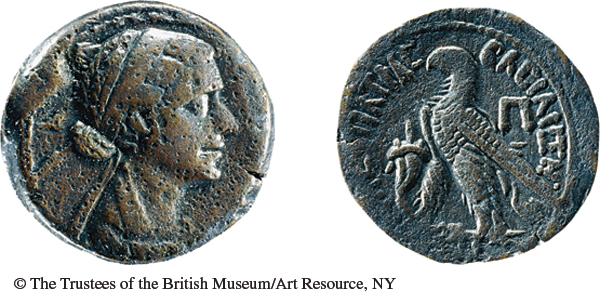A History of Western Society: Printed Page 148
A History of Western Society, Concise Edition: Printed Page 146
Individuals in Society
Queen Cleopatra
C leopatra VII (69–30 B.C.E.) was a member of the Ptolemy dynasty, the Hellenistic rulers of Egypt who had established power in the third century B.C.E. Although she was a Greek, she was passionately devoted to her Egyptian subjects and was the first in her dynasty who could speak Egyptian in addition to Greek. Just as ancient pharaohs had linked themselves with the gods, she had herself portrayed as the goddess Isis and may have seen herself as a reincarnation of Isis (see Chapter 4).
At the time civil war was raging in the late Roman Republic, Cleopatra and her brother Ptolemy XIII were in a dispute over who would be supreme ruler in Egypt. Julius Caesar captured the Egyptian capital of Alexandria, Cleopatra arranged to meet him, and the two became lovers, although Cleopatra was much younger and Caesar was married. The two apparently had a son, Caesarion, and Caesar’s army defeated Ptolemy’s army, ending the power struggle. In 46 B.C.E. Cleopatra arrived in Rome, where Caesar put up a statue of her as Isis in one of the city’s temples. The Romans hated her because they saw her as a decadent Eastern queen and a threat to what were considered traditional Roman values.
After Caesar’s assassination, Cleopatra returned to Alexandria. There she became involved in the continuing Roman civil war that now pitted Octavian, Caesar’s grandnephew and heir, against Mark Antony, who commanded the Roman army in the East. When Antony visited Alexandria in 41 B.C.E., he met Cleopatra, and though he was already married to Octavian’s sister, he became her lover. He abandoned (and later divorced) his Roman wife, married Cleopatra in 37 B.C.E., and changed his will to favor his children by Cleopatra. Antony’s wedding present to Cleopatra was a huge grant of territory, much of it Roman, that greatly increased her power and that of all her children, including Caesarion. Antony also declared Caesarion to be Julius Caesar’s rightful heir.
Octavian used the wedding gift as the reason to declare Antony a traitor. He and other Roman leaders described Antony as a romantic fool captivated by the seductive Cleopatra. Roman troops turned against Antony and joined with Octavian, and at the Battle of Actium in 31 B.C.E. Octavian defeated the army and navy of Antony and Cleopatra. Antony committed suicide, as did Cleopatra shortly afterward. Octavian ordered the teenage Caesarion killed, but the young children of Antony and Cleopatra were allowed to go back to Rome, where they were raised by Antony’s ex-

Roman sources are viciously hostile to Cleopatra, and she became the model of the alluring woman whose sexual attraction led men to their doom. Stories about her beauty, sophistication, lavish spending, desire for power, and ruthlessness abounded and were retold for centuries. The most dramatic story was that she committed suicide through the bite of a poisonous snake, which may have been true and which has been the subject of countless paintings. Her tumultuous relationships with Caesar and Antony have been portrayed in plays, novels, movies, and television programs.
QUESTIONS FOR ANALYSIS
- How did Cleopatra benefit from her relationships with Caesar and Antony? How did they benefit from their relationships with her?
- How did ideas about gender and Roman suspicion of the more sophisticated Greek culture combine to shape Cleopatra’s fate and the way she is remembered?
- In Chapter 1, “Individuals in Society: Hatshepsut and Nefertiti” also focuses on leading female figures in Egypt, but these two women lived more than a thousand years before Cleopatra. How would you compare their situation with hers?